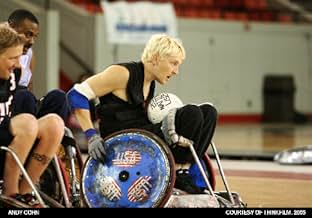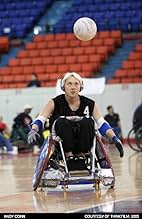Murderball
- 2005
- Tous publics
- 1h 28min
NOTE IMDb
7,7/10
11 k
MA NOTE
Ajouter une intrigue dans votre langueQuadriplegics, who play full-contact rugby in wheelchairs, overcome unimaginable obstacles to compete in the Paralympic Games in Athens, Greece.Quadriplegics, who play full-contact rugby in wheelchairs, overcome unimaginable obstacles to compete in the Paralympic Games in Athens, Greece.Quadriplegics, who play full-contact rugby in wheelchairs, overcome unimaginable obstacles to compete in the Paralympic Games in Athens, Greece.
- Nommé pour 1 Oscar
- 17 victoires et 13 nominations au total
‘Snow White’ Stars Test Their Wits
Histoire
Le saviez-vous
- AnecdotesOver 200 hours of footage was shot for this film.
- Citations
Scott Hogsett: We're not going for a hug. We're going for a fucking gold medal.
- ConnexionsFeatured in Murderball (2005)
- Bandes originalesThieves
Written by Al Jourgensen, Paul Barker, Kevin 'ohGr' Ogilvie (as Kevin Olgilvie) and Chris Connelly (as Christopher Connelly)
Performed by Ministry
Published by Warner-Tamerlane Publishing Corp. (BMI) o/b/o itself and Spurburn Music (BMI)
Courtesy of Sire Records
By Arrangement with Warner Strategic Marketing
Commentaire à la une
If, like the rest of us, you spend most of your time pissing and moaning over the seeming unfairness and petty inconveniences of everyday life, I suggest you check out "Murderball" for an immediate attitude readjustment. This fascinating documentary will put all of that stuff into perspective for you, while entertaining the hell out of you at the same time.
Played on a regulation-sized basketball court (minus the baskets), Murderball is actually a slang name for Wheelchair Rugby, an international sport in which quadriplegics use their specially armored wheelchairs almost like souped-up bumper cars to score goals for their team. The film concentrates, primarily, on the intense and sometimes downright vicious rivalry between the team from the United States and the team from Canada. The movie makers introduce us to about a half dozen players, each of whom, even in the few moments afforded him on screen, becomes a distinct personality with a history to relate and a story to tell. The two main focal points are the charismatic and muscular Mark Zupan, and Joe Soares, one of the legendary pioneers of the sport who left to coach for Canada after he was cut from the American team. Many of the most incisive scenes deal with the ribbing, some of it good-natured, some of it not so good-natured, that Soares has had to endure over his decision to defect to the opposing side.
Although the rugby scenes themselves are gripping and thrilling, the real drama occurs off the court in the men's personal lives, as we see the struggle and heartbreak the men go through, the strength and inspiration they exhibit for the rest of us, and, most especially, the camaraderie and team spirit that comes with working together to achieve a common goal. As the film-making crew follows the men around through the course of their daily lives, we get to know them as complex individuals, finding out how they ended up in a wheelchair and seeing how each was able to rise above the experience to get to where he is today. The film neither sugarcoats the difficulties of their lives nor asks for our pity. It simply presents the men to us, in all their virtues and flaws, and asks that we listen in on their stories. Some of the most poignant moments involve Soares having to come to terms with having a son who has little or no interest in sports, preferring the violin instead.
Kudos to directors Henry Alex Rubin and Dana Adam Shapiro for their fine work on this film, especially Rubin, who also provided the stunning camera-work for the scenes on the court. But most of our thanks should go to the men of the film and their loved ones who were willing to open up their lives to us in so vivid and honest a way. This is an inspiring and heartwarming film - the final scene is of some of the men introducing the sport to a number of injured Iraq War veterans - that will stick with you long after the closing credits.
Played on a regulation-sized basketball court (minus the baskets), Murderball is actually a slang name for Wheelchair Rugby, an international sport in which quadriplegics use their specially armored wheelchairs almost like souped-up bumper cars to score goals for their team. The film concentrates, primarily, on the intense and sometimes downright vicious rivalry between the team from the United States and the team from Canada. The movie makers introduce us to about a half dozen players, each of whom, even in the few moments afforded him on screen, becomes a distinct personality with a history to relate and a story to tell. The two main focal points are the charismatic and muscular Mark Zupan, and Joe Soares, one of the legendary pioneers of the sport who left to coach for Canada after he was cut from the American team. Many of the most incisive scenes deal with the ribbing, some of it good-natured, some of it not so good-natured, that Soares has had to endure over his decision to defect to the opposing side.
Although the rugby scenes themselves are gripping and thrilling, the real drama occurs off the court in the men's personal lives, as we see the struggle and heartbreak the men go through, the strength and inspiration they exhibit for the rest of us, and, most especially, the camaraderie and team spirit that comes with working together to achieve a common goal. As the film-making crew follows the men around through the course of their daily lives, we get to know them as complex individuals, finding out how they ended up in a wheelchair and seeing how each was able to rise above the experience to get to where he is today. The film neither sugarcoats the difficulties of their lives nor asks for our pity. It simply presents the men to us, in all their virtues and flaws, and asks that we listen in on their stories. Some of the most poignant moments involve Soares having to come to terms with having a son who has little or no interest in sports, preferring the violin instead.
Kudos to directors Henry Alex Rubin and Dana Adam Shapiro for their fine work on this film, especially Rubin, who also provided the stunning camera-work for the scenes on the court. But most of our thanks should go to the men of the film and their loved ones who were willing to open up their lives to us in so vivid and honest a way. This is an inspiring and heartwarming film - the final scene is of some of the men introducing the sport to a number of injured Iraq War veterans - that will stick with you long after the closing credits.
Meilleurs choix
Connectez-vous pour évaluer et suivre la liste de favoris afin de recevoir des recommandations personnalisées
- How long is Murderball?Alimenté par Alexa
Détails
- Date de sortie
- Pays d’origine
- Site officiel
- Langue
- Aussi connu sous le nom de
- Storyville: Murderball
- Lieux de tournage
- Sociétés de production
- Voir plus de crédits d'entreprise sur IMDbPro
Box-office
- Budget
- 1 750 211 $US (estimé)
- Montant brut aux États-Unis et au Canada
- 1 531 154 $US
- Week-end de sortie aux États-Unis et au Canada
- 57 286 $US
- 10 juil. 2005
- Montant brut mondial
- 1 751 895 $US
- Durée1 heure 28 minutes
- Couleur
- Mixage
- Rapport de forme
- 1.85 : 1
Contribuer à cette page
Suggérer une modification ou ajouter du contenu manquant

Lacune principale
By what name was Murderball (2005) officially released in India in English?
Répondre





























